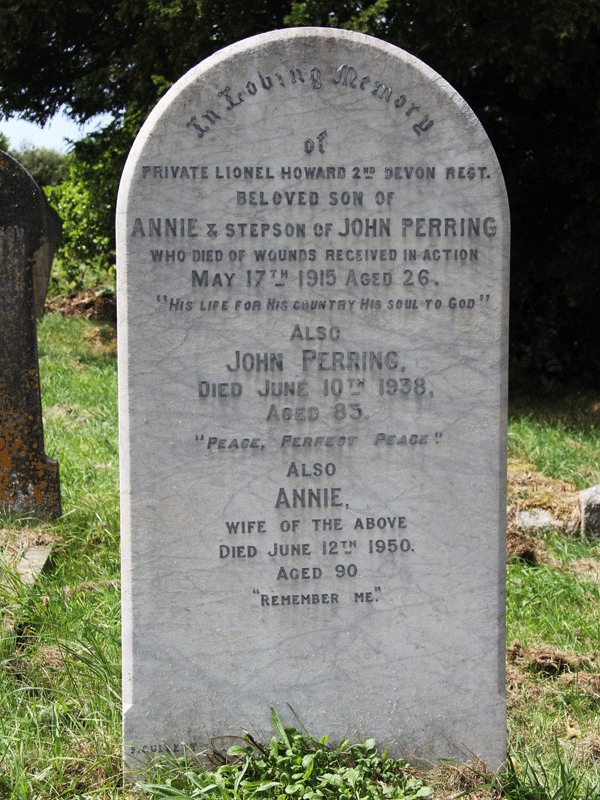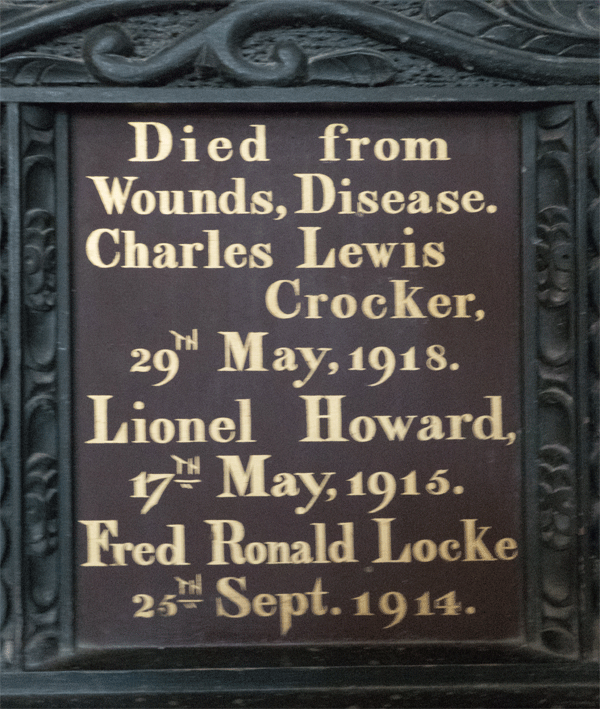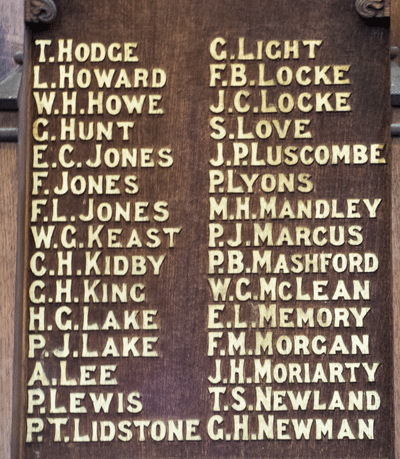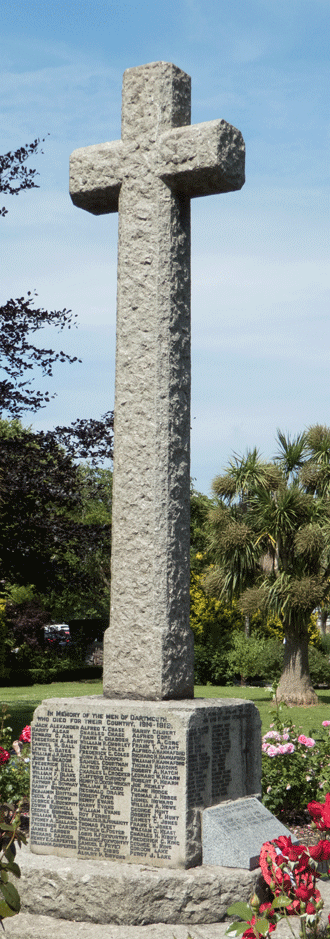Lionel Howard
Family
Lionel Rundle Howard was born in 1889 in Dartmouth. He was the son of Annie Laura Howard, who was unmarried at the time of his birth.
Annie was born in Dartmouth on 3rd December 1859, the daughter of Thomas Howard and his wife Betsey Richards Rawl (sometimes spelt Roll), both of whom were born in Dartmouth. Thomas was a tailor, as his father, John Howard, was before him, and his wife Betsey also worked as a tailoress. Thomas and Betsey married in 1845 and (according to Census records) had five children: Thomas Rawl, Hine Harris, Betsy, Annie Laura, and Helena Freda. The eldest, Thomas Rawl Howard, became a Customs House Officer, but the other children all went into the same business as their father, including the girls. In 1881 the Census recorded the family in Hanover Square, Dartmouth. Thomas and Hine were both working as tailors and Betsey (senior) as a tailoress; Betsy (junior), Annie, and Helena were all dressmakers.
Betsy (senior) died in 1885 and Thomas in 1888. Annie had thus to support herself and her young son. In the 1891 Census she and Helena were living in Victoria Place Dartmouth, both single, and both working as dressmakers. With them was Lionel, aged 2 (the Census enumerator has recorded his name as "Louise").
On 21st May 1894 Annie married John Perring at St Saviours, Dartmouth. John Perring, a seaman, was the son of another John Perring, the "Captain of the Steam Tug Hauley" according to his 1881 and 1891 Census entries, but by then retired. John Perring (junior) lived in Sparks Hill and Annie in Smith Street. Witnesses to the marriage were her sister, Helena, and brother, Hine.
Annie and John had four children of their own: Helena ("Lena"), Jack, Kathleen ("Katie") and Edwina. In the 1911 Census they were living at "Rovingsea", Bayards Cove, Dartmouth. Lionel was recorded in that Census as a Clerk working for a Grocer; according to the piece about him published in the Dartmouth Chronicle at the time of his death, his employer was Messrs Bartlett & Co, one of the biggest Dartmouth stores. He had started work early - the 1901 Census recorded him age 12, not at school but a "newsboy hawk" - selling newspapers in the street.
The Dartmouth Chronicle also recorded (at the time of his death) that he was a member of the Bible class at St Barnabas Church until he left the town.
Service
At the outbreak of war Lionel had left Dartmouth and was employed at Wilson's Stores, Exmouth. We know also from the newspaper report of his funeral that he had a "sweetheart", Miss Ethel Gollop. However, "he gallantly responded to the call of his King and country and enlisted in the 2nd Devons, acting in the capacity of a signaller". According to "Soldiers Died in the Great War", he enlisted at Exeter.
His service papers have not survived but the 1915 Medal Roll shows that he disembarked in France on 9th February 1915. The Regimental History states that the demands of the 1st and 2nd Battalions (which were already in France) were "insatiable ... between January 1st and April 30th 1915 no less than 675 other ranks left the 3rd Battalion to join the 1st and 795 to the 2nd" - Lionel was presumably one of the latter. The War Diary of the 2nd Battalion records two drafts of men joining in February, and another draft joining on 21st March.
The 2nd Devons were part of the 23rd Brigade, 8th Division, and were positioned at the southernmost sector of the front held by the British. Their experiences during January, February and March, including the Battle of Neuve Chapelle, are described in the story of James Maddick Moses Tuckerman, who died on the third day of that battle, 12th March 1915.
On 25th March 1915 the 8th Division was moved a little to the north, to Fleurbaix. The Regimental History records that the new lines were an improvement over those round Neuve Chapelle, in that they were dry and clean; on the other hand, the Divisional History comments that "the change of scene was not of a marked character, neither was there any noticeable alteration in the nature of the division's activities ... they passed from one offensive successfully concluded to preparation for another".
The planned offensive (now called the Battle of Aubers Ridge) was a joint offensive with the French. The Germans had moved forces from west to east, against Russia, so Marshall Joffre planned to take advantage of the reduction in troops along the Western Front by three strategic strikes against enemy communications:
- an eastward advance in Artois, near Arras, against the railway lines supplying the German armies from the north
- a northward attack from Rheims, against the German southern rail supply routes
- a north-eastward attack from the area near Verdun, to the Rhine crossings.
As there were insufficient men and munitions for all three to take place together, they were to take place in turn, with the Artois attack happening first. The French target was Vimy Ridge; the British were asked to target the Aubers Ridge, a slight rise in the land just behind the German lines on which were the villages of Aubers, Fromelles and Le Maisnil. Behind the Aubers Ridge (from the British perspective) was the city of Lille. Sir Douglas Haig planned a pincer attack in which the attack would be concentrated in two places: the Meerut and 1st Divisions were to attack eastward, south of Neuve Chapelle; and the 8th Division would attack southwards towards Aubers. The two were to join up on the Ridge.
Click here for a Google map showing the area of operations.
April was a month of preparation - on both sides; German defences had been much improved since Neuve Chapelle, with broader and deeper breastworks, heavy wire, reinforced dug-outs, and machine gun posts every 20 yards or so, just above ground level. Support and communication trenches were also strengthened.
The British plan was for a short intense bombardment in which field guns would deal with the wire and howitzers would deal with the German front-line breastworks. Heavier guns would concentrate on known strong-points behind the front, identified by air observation. This had worked at Neuve Chapelle and, nothwithstanding the strengthened German defences, was expected to work again. Lead battalions would move forward when the guns lifted to the German second line. Some parts of the German line had also been mined. The Regimental History comments: "Hopes ran high; Neuve Chapelle had seemed to promise much; this was to be a Neuve Chapelle without the hitches and delays".
Gradually the tempo of preparation increased. The 2nd Devons War Diary describes the buildup:
1st May: Sent about 320 NCOs and men to sections 1 and 2 for digging in evening under their platoon officers.
4th May: Many working parties working both in rear and in front of lines. Considerable amount of firing going on all night and some casualties.
5th May: Work going on behind trenches all day and night. Part of 2nd Scottish Rifles was rushed about 10.00pm, when covering working party in advanced trench. Enemy then retired back to their own trenches. Battalion stood to arms till about 11.30pm ... 7 or 8 men of working parties of various regiments wounded in evening.
6th May: The whole of area immediately behind trench is swarming with working parties and officers all day.
On the evening of 7th May they were warned to be ready for the attack the following day when orders were received postponing it for a day. The 8th May was "uneventful". That evening 2nd Devons moved into a block of assembly trenches. As part of 23rd Brigade, they were not in the lead, but in support.
The Battle
At 5 am on 9th May 1915 the artillery bombardment opened - including, says the Divisional History, brass mortars dating from 1840, "so great was our need of artillery". But it goes on: "the number of our guns proved utterly inadequate for the accomplishment of their tasks in the time allotted. Even at the height of the bombardment of the hostile trenches, the volume of effective fire was not sufficient to compel the German garrisons to keep under cover".
Consequently, when the main assault began at 5.40 am, it was subjected to "murderous fire" from machine guns on both flanks. Although some units reached the German lines, casualties were extremely heavy. The positions gained at such cost could not be held, and troops were forced back. Furthermore, the trenches up to the front line were dug in such a way that several changes of direction were required. This caused delay, during which the troops coming up, including the 2nd Devons, were subjected to "very heavy artillery fire and enfiladed machine gun fire from salient in enemy's trenches". The Devons suffered 200 NCOs and men killed, wounded and missing before they had even reached the front line. When they got there they found the trenches crowded with men from all units with very few officers, and huge confusion.
Even amidst all this, two companies of 2nd Rifle Brigade had managed to break through to the German lines. The Germans counter-attacked in force but, according to the Devonshire Regimental History, the Rifle Brigade "held on with the utmost tenacity. Later in the day orders were issued that after dark, the Devons and the Scottish Rifles should make one more effort to get across to their help. But, partly owing to the congestion of the front trenches, this order was cancelled". Eventually, in the early morning of 10th May, the Devons covered the Rifle Brigade's evacuation of what was a wholly untenable position.
The attack to the south of Neuve Chapelle had similarly faltered as the casualties mounted and chaos descended. The Regimental History says, bitterly: "Losses had been terrible; even the Devons, who had not got beyond the British front trenches, and had fared relatively well, had lost nearly as many as at Neuve Chapelle. For these losses there was nothing to show".
On 10th May, the War Diary says: "shelling continued on both sides during the day. Morning was spent collecting wounded and remaining dead". They were relieved in the afternoon and returned to billets. Their total casualties for the two days are given in the War Diary as two officers killed, six wounded, 235 NCOs and men killed, wounded and missing.
The attack was called off on 10th May due to insufficient artillery ammunition to continue. It was renewed a little way to the south, from 15th May, known as the Battle of Festubert.
The Eighth Division as a whole sustained 4,500 casualties, with lasting ill effects. Overall, the British suffered more than 11,000 casualties, the vast majority very close to their own front line. According to the Long Long Trail, per mile, this was one of the highest rates of loss during the entire war.
A member of one of 8th Division's Field Ambulance units, Private L Mitchell, (quoted in Lyn Macdonald's "1915: the Death of Innocence") recalled that it took three days to dress all the wounded, and at the end of the three days there were still sixty or seventy stretcher cases outside. Sometimes ambulances came back from Casualty Clearing Stations still full because the Clearing Stations had no capacity.
Death
It would seem that one of the wounded collected and, eventually, carried back along the casualty evacuation route to Blighty was Lionel Howard. The Dartmouth Chronicle of 14th May carried the following short piece:
Another Dartmouth Soldier Wounded
Yesterday official news was received by Mrs Perring of Clarence Hill Dartmouth that her son Pte Lionel Howard, 2nd Devon Regiment, has been wounded and is now lying in hospital in France.
The following week, on 21st May, it reported as follows:
It is with great regret we have to record the death of Private Lionel Howard, of the 2nd Devons, son of Mrs Perring, Clarence Hill, Dartmouth....On Sunday morning May 9th, after a counter-attack on Ypres (sic), he was returning to his trench, carrying his signalling flags, when a German sniper wounded him in one of his arms, and he was at practically the same moment severely wounded in the lower portion of his back by a machine gun. For some four hours the gallant young soldier lay on the battlefield, and was then discovered and taken to the field hospital, whence he was subsequently removed to the base hospital at Boulogne.
As soon as was deemed advisable he was brought to England, and on Friday night he arrived at Torquay with other wounded soldiers and was placed in the New Town Hall Red Cross Hospital. There he was visited by his mother, and although so terribly injured was very bright, and chatted of the time when he would again be at Dartmouth, apparently not realising the serious character of his wounds. He described the fighting as terrific, and said on the day he was wounded the British soldiers were falling all around him like flies.
Unhappily on Sunday his condition became much worse, but he still displayed a wonderful spirit, and retained consciousness until Monday evening, when in the presence of his mother, he quietly passed away.
Also in the Chronicle of 21st May 1915 was the following announcement from the family:
Deaths
Howard May 17th, at the Red Cross Hospital, Torquay, Private Lionel Howard, the dearly loved son of Annie, and stepson of John Perring, and loving brother of Lena, Kathleen, Edwina and Jack. Died of wounds received at Ypres, May 9th.
Greater love hath no man than this, that he lay down his life for his friend.
Funeral leaves the house Clarence Hill for the Cemetery on Saturday at 3 o'clock. Friends, please accept this, the only intimation.
The reference to Ypres above and in the account of how Lionel was wounded appears to be a misunderstanding of where the fighting had occurred, perhaps on the part of the family - understandably in the circumstances. But the date matches the date of the 2nd Devons participation in the Battle of Aubers Ridge, and the reference to "British soldiers falling like flies" certainly matches the accounts of that day in the Battalion War Diary and in the Regimental and Divisional History.
Lionel's funeral at Dartmouth cemetery was reported in detail in the Chronicle on 28th May:
The coffin, which was covered with the Union Jack, was brought by road to the Floating Bridge ferry, at the Dartmouth side of which it was met by a detachment of the 7th Devon Cyclists... The family mourners were:- Mrs Perring (mother), Mr J Perring (stepfather), Lena, Katie and Edwina (sisters), Mr and Mrs S Grant (uncle and aunt), Mrs Pym (aunt), Messrs Hubert and Bert Howard, Mr J Causley, Miss Ethel Gallop (sweetheart).
Others attending included Mr Jasper Bartlett, the owner of Bartlett's Stores. After the interment, the "Last Post" was sounded. The newspaper then listed a large number of floral tributes from family, from Ethel, from friends, from the owners of the store at which he had worked in Exmouth and from his fellow workers, and from the staff at the Red Cross Hospital at Torquay.
It was the second close family bereavement suffered by Lionel's aunt Mrs Pym. Her son, Frederick Roy Pym, John Perring's nephew, had been lost the previous November when HMS Monmouth was sunk at the Battle of Coronel.
Lionel is commemorated in Dartmouth's Longcross Cemetery by a private headstone, though his grave is of course an official War Grave. Also buried there were his mother, Annie Perring, and stepfather, John Perring. He is also commemorated in Dartmouth on the Town War Memorial, the St Saviours Memorial Board and the St Petrox Memorial Board.




Sources
The Long Long Trail: The Battle of Aubers
The Devonshire Regiment 1914-1918, complied by C T Atkinson, pub London and Exeter, 1926
The Bloody Eleventh, History of the Devonshire Regiment vol III 1914-1969, W J P Aggett, publ The Devonshire and Dorset Regiment, Exeter, 1995
War Diary of 2nd Battalion Devonshire Regiment, downloadable from national Archives (fee payable) reference WO 95/1712/1
The Eighth Dvision 1914-1918, Lt Col J H Boraston CB OBE and Captain Cyril E O Bax, 1926, republished Naval and Military Press
1915: The Death of Innocence, Lyn Macdonald, pub Penguin Books 1997
Information Held on Database
| Surname: | Howard |
| Forenames: | Lionel |
| Rank: | Private |
| Service Number: | 11310 |
| Military Unit: | 2nd Bn Devonshire Regiment |
| Date of Death: | 17 May 1915 |
| Age at Death: | 26 |
| Cause of Death: | Died of wounds |
| Action Resulting in Death: | Battle of Aubers Ridge |
| Place of Death: | Torquay |
| Place of Burial: | Long Cross Cemetery, Dartmouth |
| Born or Lived in Dartmouth? | Yes |
| On Dartmouth War Memorial? | Yes |
| On St Saviour's Memorials? | Yes |
| On St Petrox Memorials? | Yes |
| On Flavel Church Memorials? | No |
| In Longcross Cemetery? | Yes |
| In St Clement's Churchyard? | No |
| On a Private Memorial? | No |
| On Another Memorial? | No |















